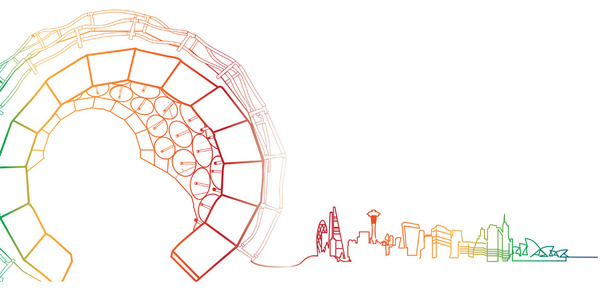|
as urban areas continue to expand to meet population and infrastructural needs, the future of cities is under intense scrutiny with engineers looking for new and sustainable models to build intelligent cities, according to an article on the princeton university website.

an artistic rendition of the thermoheliodome, a pavillion that cools itself via evaporation using mirrored panels
that reflect heat toward water-cooled pipes. (illustrations by matilda luk, office of communications)
among the many changes outlined in the article, one of the most important features of intelligent cities will be buildings that are capable of regulating internal temperature on a limited budget, both in terms of cost and energy consumption. this will require innovations in materials, construction processes, and a more resilient, sustainable electrical grid.
one structure that was designed by assistant professor forest meggers is called the thermoheliodome. the interior of the building has mirrors at odd angles to reflect heat towards water-cooled pipes. other structures use evaporation as a cooling mechanism through membranes that trap liquid water but allow water vapor to escape.
meggers created a radiative, heat-sensing camera to build 3-d models of the radiative surfaces of a room to get a better idea of the actual temperature within a space.
another building is called the cool occulus and it is designed to stay cool in the desert heat. the article explained, “during a hot day, mist flows into the oculus' central chimney and evaporates to cool the air within, which sinks as a refreshing breeze into the building. meanwhile, the structure's foundation absorbs excess heat, which it releases at night when the chimney widens to expose the foundation to the cool night sky.”
other designs are based on natural phenomena, such as the waterwheel plant, using metals that expand differently when heated to provide a shell to protect from the sun.
in addition to cooling the buildings, engineers are working on solutions for what is called “urban heat islands,” the effect of trapped heat that warms cities an average of 10-15 degrees compared to surrounding areas.
there is a lot of opportunity to make changes in urban areas, as demonstrated in hamburg, germany by the city’s decision to adopt a novel municipal underground heating system. as meggers said in the article, "cities have the power to make a change."
the article concluded, “if researchers and policymakers at princeton and in cities around the world can collaborate, making clever use of form, physics and interacting components as a part of urban planning, then that change will be a positive one.”
this article was featured in discovery: research at princeton, which can be read at https://discovery.princeton.edu/.
|